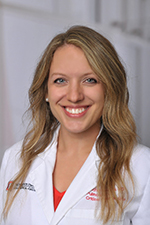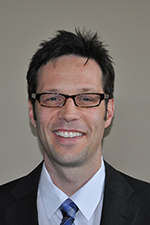Article:
Bullard MJ, Fox SM, Wares CM, Heffner AC, Stephens C, Rossi L. Simulation-based interdisciplinary education improves intern attitudes and outlook toward colleagues in other disciplines. BMC Medical Education. 2019;19(1). doi:10.1186/s12909-019-1700-1.
Summary:
This paper describes the educational learning environment impact of a novel, longitudinal, interdisciplinary and simulation-based critical care curriculum for interns. It was implemented across a healthcare system and the effect of the curriculum on interns’ attitudes and outlook on other specialties was studied. Interns who were included in this intervention reported improvements in interdisciplinary collegiality, respect, work interactions, and attitudes, plus increased comfort with interdisciplinary learning. The investigators concluded that interdisciplinary simulation-based education promotes cooperative mindsets and viewpoints at a pivotal stage in physician development. For this post, Rachel Quaney interviewed first author Mark Bullard.
Interview:
RQ: This interdisciplinary simulation-based education (IDSE) curriculum was already in place at your institution prior to this study. Tell me about when and how this was launched.
MB: To address educational challenges faced in graduate medical education two emergency medicine faculty members (myself and a former colleague) trained in simulation debriefing, as well as a behavioral psychologist, developed and implemented the program. Currently in its 9th year (developed in 2010-11, implemented in 2011-2012), the Intern Simulation Common Critical Care Curriculum (4Cs) represents a novel, sustainable, interdisciplinary simulation program which provides instruction on common critical care topics that cross all primary adult disciplines.
RQ: You stated, “it was noted during previous years’ IDSE curricula that one of the program’s implicit or ‘hidden curricula’ was the potential improvement in intern interdisciplinary attitudes.” Can you describe how this was noted and what made you decide to develop this study?
MB: I started thinking about this concept during my Masters in Health Professions Education (MS-HPEd) program at Mass General Hospital Institute for Health Professions. At the time, my program was talking about the concept of critical thinking and how the concept of critical thinking is a learned behavior. Oftentimes the practice of critical thinking is a “hidden” component in successful curricula. I then began thinking about “hidden curricula” that were imbedded within the 4Cs simulation curriculum that may have contributed to the success of this particular program. In discussions I had with residents it became apparent that global congeniality, teamwork and mutual respect for one another were factors impacting their appreciation of the program. Subsequently the hypothesis was developed and I wanted to formally study it.
RQ: Do you have a sense of how much of the changes noted in your IDSE cohort are due to the actual simulation versus time spent with other disciplines?
MB: I suspect that the changes noted are due to both. That said, I believe much like Allport’s theory: producing attitudinal change requires within learning environments and groups requires certain necessary conditions beyond that of simply having a collection of interprofessional students. The safe learning environment that we set up and maintain for our learners really is the lightning rod for the change. Upon the inception of the program, as well as in subsequent years, we have placed a great deal of focus on this environment. In many respects the learning environment may be more important to the learning than the actual curricular content. The simulation modality is certainly a component of creating this safe learning space.
RQ: What particular challenges do you face when creating and implementing a multidisciplinary simulation curriculum of this magnitude?
MB: Our division of medical education invested in this program from the beginning, and without this support the program would face many limitations and challenges. This program requires a vast amount of resources and commitment from multiple disciplines. Each residency program within our institution has embraced this program by enabling their learners to have protected educational time for each session, taking into account clinical and call schedules, independent didactics, and ACGME resident work hour restrictions. Additionally, our clinician simulation facilitators have been granted institutional protected time to invest in the education of these interns. Other domain experts such as institutional ethicists, spiritual care specialists, and risk management have volunteered to provide additional resources to the curriculum. System ancillary staff have provided assistance with scheduling and IT support for delivery of asynchronous learning materials. Finally, our simulation center has contributed resources and staffing to aid the success of the program.
RQ: Has your IDSE curriculum changed since this study was done? What changes would you like to make in the future?
MB: Through the years I have made subtle changes to the curriculum, but now in year nine we seem to have developed a “well-oiled machine”. The only change to the curriculum since the study was done is in the timing of the curriculum. Previously half of our sessions were in the evening (from 5 pm-9 pm). This was mainly due to various system time constraints. For a while we have desired to improve the program by being more learner-centric and recognized that 5-9 pm is not the best learning timeframe. This year we will be moving all sessions to daytime hours.

Blog post author
Dr. Rachel Quaney is a fellow in Pulmonary and Critical Care Medicine at The Ohio State University. She graduated from University of Kansas School of Medicine and completed Internal Medicine residency at University of South Carolina at Greenville, where she was president of House Staff Senate. Since joining OSU for fellowship training, she has developed an interest in medical education and is pursuing a Masters of Arts in Biomedical Education. She is active in the medical education community, serving as co-chair of American Thoracic Society’s TIME (Trainees Interested in Medical Education) and serves on the American Thoracic Society Training Committee, the Association of Pulmonary and Critical Care Medicine Program Directors Fellows’ Working Group, and the American College of Chest Physicians Trainee Work Group. Her research and clinical interests involve medical education, including feedback and communication, critical care, and sleep.
Twitter handle: @RachelQuaneyMD

Article author
Dr. Mark Bullard graduated from the University of Cincinnati School of Medicine in 2001, and subsequently completed his residency in emergency medicine at Carolinas Medical Center in 2004. Dr. Bullard has studied simulation education at the Center for Medical Simulation in Boston and completed his Master’s in Health Professions Education (MS-HPEd), with a focus on simulation, at Mass General Institute. Dr. Bullard has been involved throughout Atrium Health in the development and implementation of multiple educational curricula using high-fidelity medical simulation as a vehicle to train residents and other medical professionals in a consistent, safe, and efficient environment. Dr. Bullard has used a model of hands-on adult learning with guided discussion, debriefing and feedback to help define simulation as an educational modality within Atrium Health. Currently, Dr. Bullard serves as the Medical Director of Carolinas Simulation Center, Director of the Department of Emergency Medicine’s simulation program and Director for Atrium Health’s Intern Simulation Common Critical Care Curriculum (4Cs).



